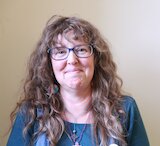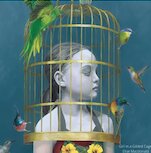Impact in Qualitative Research: Siofra Peeren, Survivors Voices & The Flying Child - Perspectives on trauma-informed public engagement workshops

Síofra Peeren, Jane Chevous, and Sophie Olson reflect on their experiences of trauma-informed public engagement workshops focused on using art to communicate research findings, and the unexpected impacts these had for each of them. Síofra Peeren is a post-doctoral survivor researcher working on a project about pathways to support for trauma at the Service User Research Enterprise at the IoPPN. Jane is a survivor researcher, writer, educator and activist with Survivors Voices. Sophie Olson is a survivor activist, writer, founder and managing director of The Flying Child: a nonprofit organisation improving awareness of child sexual abuse and the consequences of trauma.
Síofra Peeren – Researcher
Survivors of violence, abuse and trauma have long sought ways to turn painful experiences into power to create social change. As both a survivor and a researcher, I believe that involvement in research, if conducted sensitively and safely, is a key vehicle through which survivors’ voices can be heard and create change.
My PhD research aimed to understand the maternity care needs of survivors of sexual violence. During my research, survivors told me about being re-traumatised by care. Too often, women were treated as if they were just a body, not a whole person, and this felt very similar to the way they were treated by those who had abused them. In one word, what survivors needed most from health care providers was empathy.
This focus on empathy inspired me to find a way to communicate my findings through art. Art allows us to have an emotional response to experiences that may be quite alien to us, and so it is a powerful way to increase empathy. I wanted to find a way to communicate to survivors mothers that they were not alone, as many women told me about the shame they felt when they struggled with aspects of pregnancy, birth, motherhood and care.
We wanted involvement to feel liberating, creative and joyful
I worked with a survivor-led organisation, Survivors Voices, to co-facilitate public engagement workshops with a group of survivor mothers and a professional artist. Together, we came up with ideas for artwork to communicate survivors’ experiences of pregnancy, birth and maternity care. We wanted involvement to feel liberating, creative and joyful – three key principles from the Survivors Voices ‘Turning Pain into Power Charter’ (Perôt et al., 2018). So, each workshop began and ended with a grounding session from a trauma-informed yoga instructor, we established group boundaries, and we welcomed all experiences – both positive and negative – into discussions.
It soon became apparent that the workshops themselves were creating impact
Before the workshops, I was focused on the impact the artwork could have (i.e. the output). However, it soon became apparent that the workshops themselves were creating impact. Women told me that the workshops had provided a safe space to connect with other survivor mothers. They had felt able to talk about experiences and feelings that they had not felt able to talk about before, counteracting the silencing and shame that surrounds sexual violence. The artwork produced from the workshops will be showcased in a public exhibition to increase awareness and understanding of maternity care needs among survivors, and may be used in a future resource for survivors and/or service providers.
Below, Jane Chevous from Survivors Voices, who co-facilitated the workshops, and Sophie Olson from The Flying Child, who participated in the workshops, tell us about their experience in their own words.

Jane Chevous - Survivors' Voices
I always find supporting research workshops with survivors a rewarding experience; it is a privilege to hold a safe space where we can find validation and encouragement in being with others who see, hear and understand us. Each time I learn more about how to carefully put in place the ‘scaffolding’ that supports safety; knowing this demands time, attention and responsiveness, as we can never predict what will arise from the research process.
I expected the workshops to facilitate healing conversations, and unearth powerful images to communicate our experiences and insights to others. I didn’t expect to find such a unique and vital space
Art can be part of creating that ‘safe space’ for survivors (Rouse et al 2022), as well expressing trauma more effectively, an embodied experience that is often beyond words (Abramson & Abramson, 2019, 2020). I expected the workshops to facilitate healing conversations, and unearth powerful images to communicate our experiences and insights to others. I didn’t expect to find such a unique and vital space, which as a mother and CSA/rape survivor I had never before entered. It was so profound and moving to have honest and vulnerable conversations about the challenges, difficulties and re-traumatisation of entering motherhood as a survivor. We were able to be real with each other, and reveal fears and wounds that I had never imagined being able to speak of to another person.
Art can be seen as a social movement that disrupts the status quo (Daykin 2020), and I hope and trust that the artwork and research findings will improve practice in maternal care. For me the most significant impact is the disruption of shame, that the research process has enabled. I no longer feel such shame about my experiences as a survivor-parent. And my belief has been confirmed that shame-sensitive, as well as trauma-informed practice, is key to healing our collective and individual trauma.

Sophie Olson - The Flying Child
As part of my work, I regularly talk about my experience of Childhood Sexual Abuse (CSA) and the consequences on the adult I became. I was keen to join the workshops because CSA had a direct impact on my pregnancies, birth and beyond. I felt drawn to the creative nature of the project and welcomed the opportunity to influence change.
I felt drawn to the creative nature of the project and welcomed the opportunity to influence change
I have seen a shift over the years from experts by experience being used in coproduction as a tokenistic gesture, to involvement at all stages of research. This is encouraging because those with first-hand experience are better placed to highlight issues, identify possible solutions and to challenge attitudes, myths and misconceptions that act as a barrier when implementing necessary change - especially important in CSA. My own work has highlighted quite how misunderstood CSA and its legacy is - and this is because of the taboo and culture of silence. It’s challenging to get a comprehensive understanding of the impact without the voices of the survivors themselves.
My own work has highlighted quite how misunderstood CSA and its legacy is - and this is because of the taboo and culture of silence
I have taken part in many research projects, and the workshops were a perfect example of trauma informed coproduction. Regardless of where survivors might be in their healing journey; recall of trauma is challenging and so careful consideration of how to safely hold a group is imperative. A check in at the start and knowing I could turn off my camera helped me to feel calm and regulated. I am grateful when a researcher gives me extensive information about the project before, during and after, as it makes me feel more in control, and my trauma not used or exploited. The yoga instructor was a thoughtful extra. It was a respectful space.
Most importantly, because it was survivor informed, the outcome will not perpetuate the myths and stereotypes that are so damaging to survivors in society.
References
Abramson, T.L., & Abramson, P. R. (2019) Charting New Territory: the Aesthetic Value of Artistic Visions That Emanate in the Aftermath of Severe Trauma, Contemporary Aesthetics.
Abramson, P.R., & Abramson, T.L. (2020) Should Art About Child Abuse Be Exhibited in Corridors of Health Professional Schools? AMA J Ethics.
Daykin, N. (2020). Arts, health and well-being: A critical perspective on research, policy and practice. Routledge
Perôt, C., Chevous, J., & Group, S. V. R. (2018). Turning Pain into Power: A Charter for Organisations Engaging Abuse Survivors in Projects, Research & Service Development.
Rouse, A., Jenkinson, E. & Warner, C.(2022) The use of “art” as a resource in recovery from the impact of sexual abuse in childhood: A qualitative systematic review, Arts & Health.